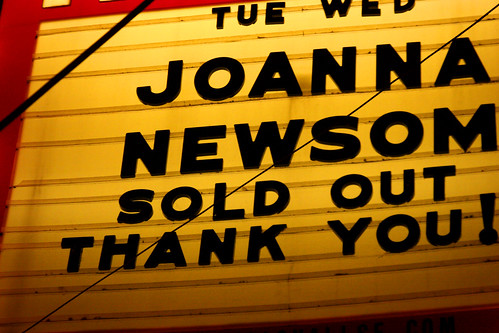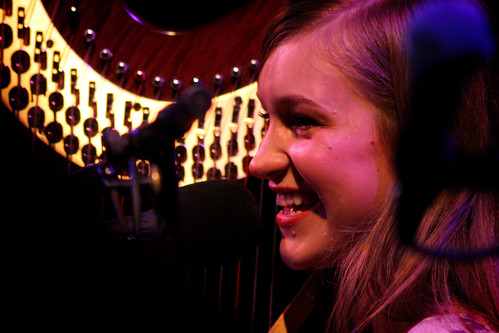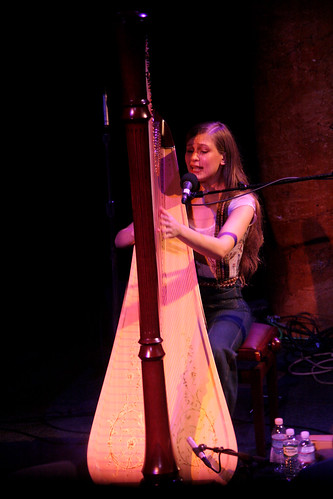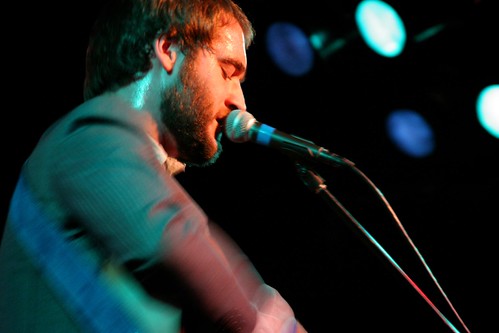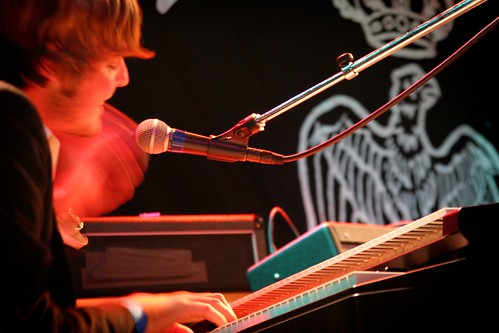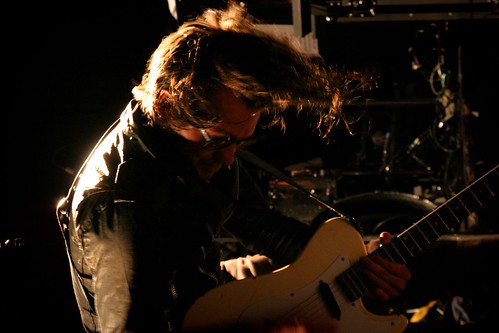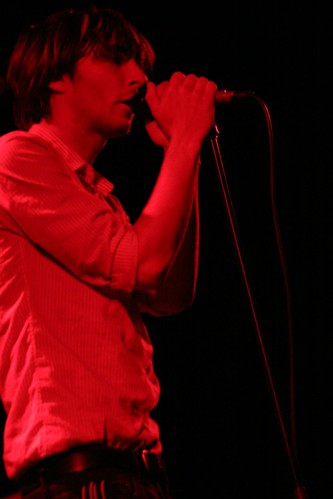19 December 2006
Joanna Newsom
Great American Music Hall
859 O'Farrell Street (btwn Polk & Larkin) [Map]
Drinks Consumed: 1 beer and a shot; a bottle of water when I almost passed out on the floor
Review at the Owl Mag
Joanna Newsom's sold out show at the Great American Music Hall on December 19 marks the first time I've been shushed at a show since I yelled, "Fuck yeah!" at a Kings of Convenience show when they played the chorus of Pavement's "Range Life." We were even shushed between songs, and jKoshi, who took the photos for this review, got a few dirty looks for his camera being too loud while he snapped shots. So to say that Newsom attracts a unique crowd is an understatement. As a friend put it, a strange cult of personality accompanies Newsom, and it transcends the Newsom clone haircuts donned by girls in the audience. A large portion of the crowd took this show too seriously. Yes, her music is quiet and beautiful, but talking to friends in "inside voices" while standing 10 feet from the bar does not warrant angry looks or SHHHH's. It made the audience seem a little...fanatical.
Also worth note: Newsom plays seated at her harp so unless you were right up front or in a premium spot in the balcony she was very difficult to see. Those of us in the crowd under 5'8" were forced to make due with quick glimpses between heads in the crowd. A venue with tiered seating would be better suited for the show.
Silence Nazis and neck craning aside, the show was amazing. Newsom came onstage alone and opened with "Bridges and Balloons," followed by "Sadie," both from her 2003 debut, The Milk-Eyed Mender. An Appalachian-style folk quintet joined her onstage after the third song, bearing everything from a saw to a mandolin. They played "Emily," the first track on her critically acclaimed 2006 release, Ys. The five-track album features Newsom backed by an orchestra, so the substitution of the folk band brought something a little different—dare I say "freak-folk"—to the performance. Debates over whether or not the compositions of Smile collaborator Van Dyke Parks really do her justice became irrelevant as the band interpreted Parks' orchestration. They played Ys in its entirety and the crowd hung on every screech of her voice and pluck of the harp as if she had cast some kind of evil spell on them.
The band and Newsom returned for the encore with a new song—some kind of Appalachian freak-folk jam session—that is hopefully not a sign of Joanna Newsom albums to come. When the song finally ended (and I mean finally, it dragged on for what seemed like fifteen minutes) the band cleared the stage, leaving only Newsom and her harp once more. She closed with two more songs from her first album, "Peach, Plum, Pear" and "Clam, Crab, Cockle, Cowrie." Between her prodigious skills as a harpist, an imagination that would make T.H. White jealous, and her penchant for words like "dirigible" and "taciturn," Newsom lives up to the hype she has been afforded by critics. And, really, when was the last time you heard a musician reference "Sisyphus?"
Saturday, December 23, 2006
Tuesday, September 26, 2006
Just What the Doctor Ordered and More at Doc's Clock
Doc's Clock
2575 Mission Street (@ 22nd) [Map]
Total Spent: $2 for 9 songs
Doc's Clock is known for its shuffleboard table, but don't be too distracted: the jukebox is great too. While the bar tends to get crowded on weekend nights, it is almost always empty early, making it easy to find a seat and monopolize the jukebox. According to something (I can't remember if it was a sign or a conversation with a bartender, blame the beer) the bar has occupied its spot on Mission Street since the end of Prohibition. Fortunately, the jukebox has been updated significantly more than the curios strewn about the bar.
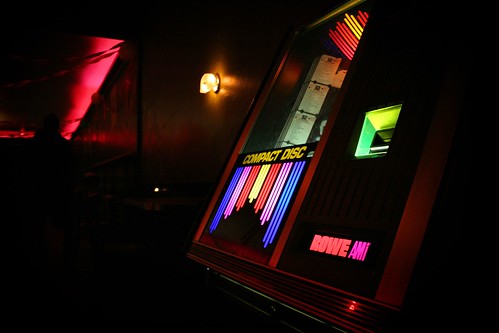
When I say that you can find everything in this jukebox, I mean that nearly every major genre is represented. No, you won't see "grindcore" or "screamo" or other genres that aren't necessary in the first place, but you will see the big ones that matter. There are some great booze-, drug-, and debauchery-themed old jazz compilations in addition to Louis Armstrong and guitarist Django Reinhardt. Buck Owen and Wayne Hancock are two great country artists in the juekbox, and Buddy Holly, Bo Diddley, Jerry Lee Lewis, and Roy Orbison represent the early days of rock n roll. There are a couple ska compilations (Toots & the Maytal ska, not Sugar Poppin Daddies) and an assortment of Latin bands whose names contain "Los."
One thing that this jukebox does not fear is indie rock, and if that's your thing you will be pleased here. There are several Broken Social Scene albums sprinkled amid Two Gallants, the Raconteurs, and Nouvelle Vague. And, of course, there's the usual punk, from the Sex Pistols to the Buzzcocks. Sharon Jones & the Dap Kings make an appearance, as do Howlin' Wolf and Otis Redding. Alas, Sam Cooke is nowhere to be found.
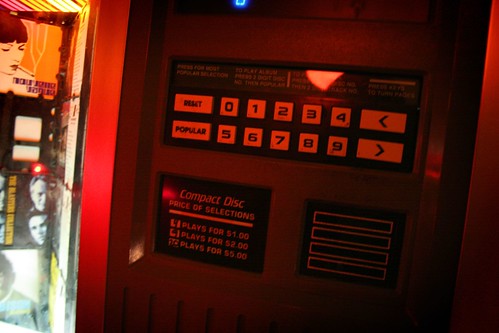
You would think that a jukebox of this caliber would come at a premium, but it doesn't. It's actually one of the best deals I've found so far: 4 plays for $1, 9 plays for $2, and a whopping 20 plays for $5. That's beautiful. Had I been less thirsty, I would've put $5 in the jukebox and easily found 20 songs worth playing. But one must maintain a delicate balance between booze and music, and anyway it was only fair that I let other people play.
Based on cost and selection, the jukebox at Doc's Clock is officially one of my favorites in San Francisco.
2575 Mission Street (@ 22nd) [Map]
Total Spent: $2 for 9 songs
Doc's Clock is known for its shuffleboard table, but don't be too distracted: the jukebox is great too. While the bar tends to get crowded on weekend nights, it is almost always empty early, making it easy to find a seat and monopolize the jukebox. According to something (I can't remember if it was a sign or a conversation with a bartender, blame the beer) the bar has occupied its spot on Mission Street since the end of Prohibition. Fortunately, the jukebox has been updated significantly more than the curios strewn about the bar.

When I say that you can find everything in this jukebox, I mean that nearly every major genre is represented. No, you won't see "grindcore" or "screamo" or other genres that aren't necessary in the first place, but you will see the big ones that matter. There are some great booze-, drug-, and debauchery-themed old jazz compilations in addition to Louis Armstrong and guitarist Django Reinhardt. Buck Owen and Wayne Hancock are two great country artists in the juekbox, and Buddy Holly, Bo Diddley, Jerry Lee Lewis, and Roy Orbison represent the early days of rock n roll. There are a couple ska compilations (Toots & the Maytal ska, not Sugar Poppin Daddies) and an assortment of Latin bands whose names contain "Los."
One thing that this jukebox does not fear is indie rock, and if that's your thing you will be pleased here. There are several Broken Social Scene albums sprinkled amid Two Gallants, the Raconteurs, and Nouvelle Vague. And, of course, there's the usual punk, from the Sex Pistols to the Buzzcocks. Sharon Jones & the Dap Kings make an appearance, as do Howlin' Wolf and Otis Redding. Alas, Sam Cooke is nowhere to be found.

You would think that a jukebox of this caliber would come at a premium, but it doesn't. It's actually one of the best deals I've found so far: 4 plays for $1, 9 plays for $2, and a whopping 20 plays for $5. That's beautiful. Had I been less thirsty, I would've put $5 in the jukebox and easily found 20 songs worth playing. But one must maintain a delicate balance between booze and music, and anyway it was only fair that I let other people play.
Based on cost and selection, the jukebox at Doc's Clock is officially one of my favorites in San Francisco.
Sunday, September 24, 2006
23 Sep 2006: Phoenix and La Rocca
23 September 2006
Phoenix with La Rocca
Slim's
333 11th Street (btwn Folsom & Harrison) [Map]
Drinks Consumed: Numerous beers, too numerous to count.
Review at the Owl Mag
Watching Phoenix with La Rocca at Slim's marks the first time I felt like I was among the oldest people at a show, and I'm only 25. The place was packed with teenagers, which was puzzling considering Phoenix has been around since 1999. Then again, Modest Mouse spent 7 years playing for drunk indie fans in tiny venues before they hit the top 40 charts, made all the teenyboppers howl along to "Float On," and found themselves covered on a KidSongs album. But I digress...
La Rocca's frontman Bjorn Baillie summed it up early on: "We're a fucking Irish band." His proclamation of Irishness lends me a free pass to compare them to other Irish bands. To expound, they're an indie rock/pop band in the vein of The Thrills— and at times they even sound a little like U2. Their rock is not innovative but it is fun. Keyboardist Nick Haworth's melodic keyboard parts prevent them from sounding wholly unoriginal and he's a treat to watch on stage. His hunched figure lays into the keys with a kind of hypnotic vigor reminiscent a great jazz pianist. Instead of a cigarette hanging from his lip, though, he had a bottle of Bushmill's under his bench and a microphone.
They opened with "Sketches (20 Something Life)," the catchy first track on their debut album The Truth, and followed with the more reticent "I Will Need Morning." There's something super polished about the album, so to hear the songs with the raw energy of a live performance gave me an appreciation for their music I didn't get from the album alone. They are the same band playing the same music but their energy live makes them a much more interesting band than their album might lead you to believe they are. They put on a hell of a show and watching the lead singer drool all over his microphone (he promised umbrellas for future performances) was just an added bonus.
While La Rocca surprised me, Phoenix let me down—but judging by the crowd's reactions, I was the only one who felt that way. I'm not sure why Phoenix decided that they wanted to be a rock band. It's Never Been Like That is wholly unlike their first album, United, save a few songs that betray remnants of their notable electro pop style. It must be evolutionary, since 2004 release Alphabetical fell somewhere between the former and latter, but they were something special when they focused on the electronic stuff. That's right kids—and I mean that literally—Phoenix did not used to sound like just another indie rock band.
The entrance was rather dramatic. I couldn't tell if a band or the Lakers were going to come onstage. The place went dark except for a few spinning spotlights, then some really cheesy NBA intro-style music played and the band came onstage to riotous applause. "Napoleon Says," one of the New Phoenix rock/pop tracks, and the just-a-little-electronic "Long Distance Call," both from this year's release, It's Never Been Like That, came first. They followed with "Everything, Everything" from Alphabetical. At this point, a 14-year-old girl snuck into the space in front of me and proceeded to rock out, lashing me with her Pantene Pro V hair. This is consequently the point where I looked around and realized that well over half of the crowd was not yet of voting age, which explained why the bartender wasn't just friendly but seemed eager to pour me beers.
Naturally, for me, the highlight of the show was when they put their rock band fantasies aside and played three tracks from United: "Funky Square Dance," "If I Ever Feel Better," and "Too Young," the song made popular by its inclusion on the Lost In Translation soundtrack. (Useless fact: director Sofia Coppola and lead singer Thomas Mars are having a child together.) Although they plunged into a guitar rock version of "If I Ever Feel Better" at the end of the song, they fortunately haven't completely forsaken their electro pop roots.
Despite my hang-ups, overall the show was everything a live indie rock show should be, and I'm glad I got to see La Rocca. As far as Phoenix goes, it's a vain hope that this rock thing is just a phase and they will go back to what they do best. But their teenage fan club, seems to think that they are fine just the way they are so we're not likely to hear another album like United any time soon.
Phoenix with La Rocca
Slim's
333 11th Street (btwn Folsom & Harrison) [Map]
Drinks Consumed: Numerous beers, too numerous to count.
Review at the Owl Mag
Watching Phoenix with La Rocca at Slim's marks the first time I felt like I was among the oldest people at a show, and I'm only 25. The place was packed with teenagers, which was puzzling considering Phoenix has been around since 1999. Then again, Modest Mouse spent 7 years playing for drunk indie fans in tiny venues before they hit the top 40 charts, made all the teenyboppers howl along to "Float On," and found themselves covered on a KidSongs album. But I digress...
La Rocca's frontman Bjorn Baillie summed it up early on: "We're a fucking Irish band." His proclamation of Irishness lends me a free pass to compare them to other Irish bands. To expound, they're an indie rock/pop band in the vein of The Thrills— and at times they even sound a little like U2. Their rock is not innovative but it is fun. Keyboardist Nick Haworth's melodic keyboard parts prevent them from sounding wholly unoriginal and he's a treat to watch on stage. His hunched figure lays into the keys with a kind of hypnotic vigor reminiscent a great jazz pianist. Instead of a cigarette hanging from his lip, though, he had a bottle of Bushmill's under his bench and a microphone.
They opened with "Sketches (20 Something Life)," the catchy first track on their debut album The Truth, and followed with the more reticent "I Will Need Morning." There's something super polished about the album, so to hear the songs with the raw energy of a live performance gave me an appreciation for their music I didn't get from the album alone. They are the same band playing the same music but their energy live makes them a much more interesting band than their album might lead you to believe they are. They put on a hell of a show and watching the lead singer drool all over his microphone (he promised umbrellas for future performances) was just an added bonus.
While La Rocca surprised me, Phoenix let me down—but judging by the crowd's reactions, I was the only one who felt that way. I'm not sure why Phoenix decided that they wanted to be a rock band. It's Never Been Like That is wholly unlike their first album, United, save a few songs that betray remnants of their notable electro pop style. It must be evolutionary, since 2004 release Alphabetical fell somewhere between the former and latter, but they were something special when they focused on the electronic stuff. That's right kids—and I mean that literally—Phoenix did not used to sound like just another indie rock band.
The entrance was rather dramatic. I couldn't tell if a band or the Lakers were going to come onstage. The place went dark except for a few spinning spotlights, then some really cheesy NBA intro-style music played and the band came onstage to riotous applause. "Napoleon Says," one of the New Phoenix rock/pop tracks, and the just-a-little-electronic "Long Distance Call," both from this year's release, It's Never Been Like That, came first. They followed with "Everything, Everything" from Alphabetical. At this point, a 14-year-old girl snuck into the space in front of me and proceeded to rock out, lashing me with her Pantene Pro V hair. This is consequently the point where I looked around and realized that well over half of the crowd was not yet of voting age, which explained why the bartender wasn't just friendly but seemed eager to pour me beers.
Naturally, for me, the highlight of the show was when they put their rock band fantasies aside and played three tracks from United: "Funky Square Dance," "If I Ever Feel Better," and "Too Young," the song made popular by its inclusion on the Lost In Translation soundtrack. (Useless fact: director Sofia Coppola and lead singer Thomas Mars are having a child together.) Although they plunged into a guitar rock version of "If I Ever Feel Better" at the end of the song, they fortunately haven't completely forsaken their electro pop roots.
Despite my hang-ups, overall the show was everything a live indie rock show should be, and I'm glad I got to see La Rocca. As far as Phoenix goes, it's a vain hope that this rock thing is just a phase and they will go back to what they do best. But their teenage fan club, seems to think that they are fine just the way they are so we're not likely to hear another album like United any time soon.
Tuesday, July 11, 2006
Not Just for Superman: Rocking Out at the Phone Booth
The Phone Booth
1398 South Van Ness Ave (@ 25th St.) [Map]
415-648-4683
Sadie's Flying Elephant
491 Potrero (@ Mariposa) [Map]
415-551-7988
Running a good neighborhood bar means more than stocking the Jack Daniels, cleaning the taps, and offering cheap cans of Tecate. It's also about making the bar a place the patrons can call "home." And what better way to create an environment than by filling the jukebox full of stuff that will make even the snootiest music snob smile? Steve S., owner of the Mission's Phone Booth and Sadie's Flying Elephant (a recent acquisition in Potrero Hill), weighs in on what it takes to have a fantastic jukebox.
How much input do you allow your staff to have regarding what goes in the jukebox?
Very little. Our tastes are relatively the same. They moan and groan, but mostly on what we don't take off. Mostly things that they are sick of hearing, like Guns and Roses Appetite For Destruction. The bar staff couldn't wait for that to be taken off.
Do you feel that a bar’s jukebox is important to the bar’s identity?
Absolutely. That's why it's best to have one person in charge of the inventory.
What are some of your favorite things in your jukeboxes?
I don't have any particular favorites. I love turning people onto new stuff. We had Arcade Fire, Ambulance LTD, Peaches, Nine Black Alps, TV On The Radio, etc. way before any of it was hip or mainstream. We've removed CD's because of lack of enthusiasm from our customers only to return it and then remove it again because it ventured into overkill mode.
Do you leave things in there just because people like to hear them even if they make you cringe when they're played?
None of it makes me cringe. We buy every CD that goes into our boxes; you can't leave it up to the jukebox company. We usually leave in the classics much longer than anything new. And we replace classic act albums by Zeppelin, Bowie, Stones, etc. all the time. At The Phone Booth we've had Husker Du, The Cramps, The Runanaways, Sweet, and others on the box from day one, April 1, 1999. We change our selections regularly, much more so than other boxes tended to by our jukebox guys (according to them anyway).
What do you think of MP3 jukeboxes? Have you considered investing in the eCast service?
We've been approached by this and don't feel it fits our demographic or our identity. Those boxes hold everything, so we may be forced to listen to [anything from] Liza Minelli, Barry Manilow, Barbra Streisand to Britney Spears and N'Sync, which would induce more than cringing. We have many regulars who would welcome a chance to play those things; but, no.
How does the jukebox at Sadie’s compare to the one at the Phone Booth? Do you favor one over the other?
Sadie's is much more rock-oriented. Lots of old-school NY and LA Punk. It's newer and still finding its niche. The biggest difference is that there is no duplication, that I can recollect. Sadie's is more Jayne County and the Electric Chairs/Johnny Cash while the Phone Booth is more Television/Dolly Parton. The Phone Booth has been in our hands a lot longer than Sadie's so the collection is much easier to manipulate.
Do you have a favorite jukebox in the city that is not stocked by you?
Hmm. It's been awhile since I've been out any other place besides the obvious. A few, possibly many, years ago, I was at Lucky 13, and I loved their jukebox. It was
chock full of good ol' punk rock. Lots of local SF bands, which had a relatively ignored scene back in the day, the likes of CRIME and The Avengers and heavy duty Stooges, MC5, Detroit style rock. It was old school and I loved it. Haven't been back and not sure if it's changed or not. It wouldn't need to.
1398 South Van Ness Ave (@ 25th St.) [Map]
415-648-4683
Sadie's Flying Elephant
491 Potrero (@ Mariposa) [Map]
415-551-7988
Running a good neighborhood bar means more than stocking the Jack Daniels, cleaning the taps, and offering cheap cans of Tecate. It's also about making the bar a place the patrons can call "home." And what better way to create an environment than by filling the jukebox full of stuff that will make even the snootiest music snob smile? Steve S., owner of the Mission's Phone Booth and Sadie's Flying Elephant (a recent acquisition in Potrero Hill), weighs in on what it takes to have a fantastic jukebox.
How much input do you allow your staff to have regarding what goes in the jukebox?
Very little. Our tastes are relatively the same. They moan and groan, but mostly on what we don't take off. Mostly things that they are sick of hearing, like Guns and Roses Appetite For Destruction. The bar staff couldn't wait for that to be taken off.
Do you feel that a bar’s jukebox is important to the bar’s identity?
Absolutely. That's why it's best to have one person in charge of the inventory.
What are some of your favorite things in your jukeboxes?
I don't have any particular favorites. I love turning people onto new stuff. We had Arcade Fire, Ambulance LTD, Peaches, Nine Black Alps, TV On The Radio, etc. way before any of it was hip or mainstream. We've removed CD's because of lack of enthusiasm from our customers only to return it and then remove it again because it ventured into overkill mode.
Do you leave things in there just because people like to hear them even if they make you cringe when they're played?
None of it makes me cringe. We buy every CD that goes into our boxes; you can't leave it up to the jukebox company. We usually leave in the classics much longer than anything new. And we replace classic act albums by Zeppelin, Bowie, Stones, etc. all the time. At The Phone Booth we've had Husker Du, The Cramps, The Runanaways, Sweet, and others on the box from day one, April 1, 1999. We change our selections regularly, much more so than other boxes tended to by our jukebox guys (according to them anyway).
What do you think of MP3 jukeboxes? Have you considered investing in the eCast service?
We've been approached by this and don't feel it fits our demographic or our identity. Those boxes hold everything, so we may be forced to listen to [anything from] Liza Minelli, Barry Manilow, Barbra Streisand to Britney Spears and N'Sync, which would induce more than cringing. We have many regulars who would welcome a chance to play those things; but, no.
How does the jukebox at Sadie’s compare to the one at the Phone Booth? Do you favor one over the other?
Sadie's is much more rock-oriented. Lots of old-school NY and LA Punk. It's newer and still finding its niche. The biggest difference is that there is no duplication, that I can recollect. Sadie's is more Jayne County and the Electric Chairs/Johnny Cash while the Phone Booth is more Television/Dolly Parton. The Phone Booth has been in our hands a lot longer than Sadie's so the collection is much easier to manipulate.
Do you have a favorite jukebox in the city that is not stocked by you?
Hmm. It's been awhile since I've been out any other place besides the obvious. A few, possibly many, years ago, I was at Lucky 13, and I loved their jukebox. It was
chock full of good ol' punk rock. Lots of local SF bands, which had a relatively ignored scene back in the day, the likes of CRIME and The Avengers and heavy duty Stooges, MC5, Detroit style rock. It was old school and I loved it. Haven't been back and not sure if it's changed or not. It wouldn't need to.
Wednesday, May 03, 2006
More than the Indigo Girls at Wild Side West
Wild Side West
425 Cortland Avenue (at Wool St) [Map]
Total Spent: $1 (but it could easily have been much more)
Tucked away in homey Bernal Heights, the rule at Wild Side West is ladies first. The Salvation Army decorations inside are reminiscent of a kitschy saloon, complete with a sad hobo leaning on a little streetlamp next to the ancient cash register (which still works). The true greatness of this place, though, is through the back door, past the bathrooms, and down the stairs. Unlike so many outdoor drinking areas in the city, this one feels like you've stumbled upon a brilliant secret. The seating areas are arranged so that you and your friends have your own private little niche among the tall flowers, lemon trees, hubcaps, and amateur pottery.
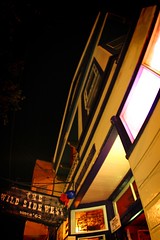
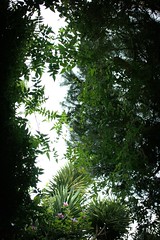
The wall-mounted jukebox is located next to the front door and the volume is kept at such a level that you can't really hear it out back in the garden. However, since I made the mistake of allowing a male friend to step up to the bar and buy a round, I was able to spend more time inside than planned. Unfortunately, nothing stood out while we watched the women get beers first, except for something that sounded like a Peaches song. But when we did our frenzied flip through on the way out the door we found a rather odd collection.
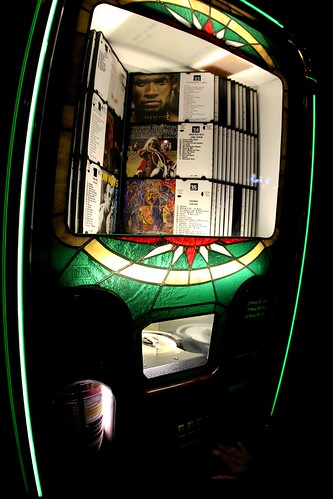
For starters,the jukebox is packed with ladies—Fiona Apple, Indigo Girls, Sade, Le Tigre, and the Dixie chicks all have albums behind the glass. But it gets much more interesting. Mixed in among the collection of standard classic rock and chick rock, you'll find The Best of Leonard Cohen and Tom Waits' Rain Dogs. The juke even ventures into the top 40 charts with Usher, 50 Cent, and a 2005 Grammy nominee compilation. One can only hope these are included for kicks, like the random arrangement of worn out shoes above the bar's fireplace.

This jukebox does contain some very impressive gems. I was delighted to see a full album from contemporary blues legend Taj Mahal as well as an album by jazz guitarist Stanley Jordan. Gillian Welch's accomplished Revival also makes an appearance. Most importantly, though, Wild Side West is the first jukebox thus far to have an entire Sam Cooke album, The Best of Sam Cooke. It's no Night Beat but it was enough for me to throw a dollar in the box and put on 3 Sam Cooke tracks as I went out the door.
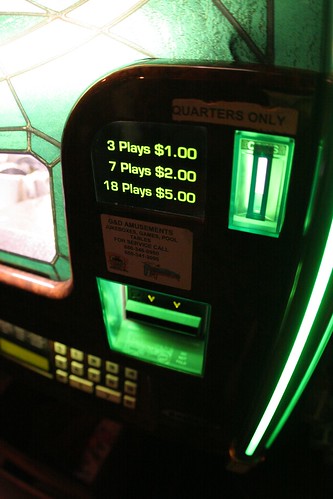
Truthfully, I was too busy enjoying the nice weather, beer, the company of friends, and the impromptu jam session in the garden to get a feel for what people do with the jukebox. However, it is still very clear that the jukebox's collection is well-suited to the bar patrons, who range from neighborhood lesbians to Zeitgeist refugees. It is not by any means an average jukebox, nor should it be since Wild Side West is not your average bar.
425 Cortland Avenue (at Wool St) [Map]
Total Spent: $1 (but it could easily have been much more)
Tucked away in homey Bernal Heights, the rule at Wild Side West is ladies first. The Salvation Army decorations inside are reminiscent of a kitschy saloon, complete with a sad hobo leaning on a little streetlamp next to the ancient cash register (which still works). The true greatness of this place, though, is through the back door, past the bathrooms, and down the stairs. Unlike so many outdoor drinking areas in the city, this one feels like you've stumbled upon a brilliant secret. The seating areas are arranged so that you and your friends have your own private little niche among the tall flowers, lemon trees, hubcaps, and amateur pottery.


The wall-mounted jukebox is located next to the front door and the volume is kept at such a level that you can't really hear it out back in the garden. However, since I made the mistake of allowing a male friend to step up to the bar and buy a round, I was able to spend more time inside than planned. Unfortunately, nothing stood out while we watched the women get beers first, except for something that sounded like a Peaches song. But when we did our frenzied flip through on the way out the door we found a rather odd collection.

For starters,the jukebox is packed with ladies—Fiona Apple, Indigo Girls, Sade, Le Tigre, and the Dixie chicks all have albums behind the glass. But it gets much more interesting. Mixed in among the collection of standard classic rock and chick rock, you'll find The Best of Leonard Cohen and Tom Waits' Rain Dogs. The juke even ventures into the top 40 charts with Usher, 50 Cent, and a 2005 Grammy nominee compilation. One can only hope these are included for kicks, like the random arrangement of worn out shoes above the bar's fireplace.

This jukebox does contain some very impressive gems. I was delighted to see a full album from contemporary blues legend Taj Mahal as well as an album by jazz guitarist Stanley Jordan. Gillian Welch's accomplished Revival also makes an appearance. Most importantly, though, Wild Side West is the first jukebox thus far to have an entire Sam Cooke album, The Best of Sam Cooke. It's no Night Beat but it was enough for me to throw a dollar in the box and put on 3 Sam Cooke tracks as I went out the door.

Truthfully, I was too busy enjoying the nice weather, beer, the company of friends, and the impromptu jam session in the garden to get a feel for what people do with the jukebox. However, it is still very clear that the jukebox's collection is well-suited to the bar patrons, who range from neighborhood lesbians to Zeitgeist refugees. It is not by any means an average jukebox, nor should it be since Wild Side West is not your average bar.
Wednesday, April 26, 2006
MP3s are for iPods, not Jukeboxes
Back in the day, jukeboxes were the talk of the town. Patrons lined up to play their favorite songs in packed bars and restaurants while record labels capitalized on the promotional possibilities. Eighty years and a few format shifts later, technology is rapidly changing the way people listen to music. Enter Ecast, a San Francisco-based company of die-hard music fans that has returned the jukebox to its glory days and beyond.
— “Jukeboxes: Overview” ( www.ecacstinc.com)
Kudos to the people at Ecast for their success, but the MP3 jukebox is the worst thing to happen to bars since the invention of the Jaeger bomb. Am I a luddite? Hardly. I am obsessed with digital music technology and use it regularly. I am, however, a sucker for nostalgia, a self-proclaimed bar aficionado, and I have occasionally been dubbed a music snob. Although the gigantic library offered by Ecast (3,000 songs on the jukebox hard drive and an ever-expanding catalog of music numbering around 150,000 songs) seems like the whiskey-soaked music snob’s dream, it is really our enemy.
At face value, the MP3 jukebox seems brilliant and, truthfully, from a digital music nerd standpoint, it is, and its invention makes sense. As media technology has evolved—vinyl to cassette to CD—so has the technology of the jukebox—vinyl to CD and now to digital. The problem is that I am unable to reconcile my thirst for technology with my love of the mechanical jukebox.
The first problem with the MP3 machines is that their contents are all the same. Trying to choose 7 songs from 89 albums hand-selected by a potentially disgruntled staff, many of which I may or may not hate, is part of the fun. MP3 jukeboxes make it too easy because they has everything and what they don't have can possibly be downloaded. A press release quotes Jamie Brown, owner of San Francisco’s 540 Club:
With more than 150,000 songs to choose from on our Ecast broadband-enabled jukeboxes, listeners can always find a song they want to hear. And when new albums are released people can check them out on the jukebox in a place that’s fun to hang out, instead of going to their local record store.If the bar were located in my hometown in rural Pennsylvania, where the only local record store you will find is the $2.00 cassette tape rack at a truck stop, this would be true. But what’s so bad about record stores when your local record store is Amoeba or Aquarius? In this case, the press release is regarding the San Francisco Weekly and the SF Bay Guardian crowning the 540 Club’s Ecast MP3 jukebox “Best of San Francisco.” For shame, San Francisco.
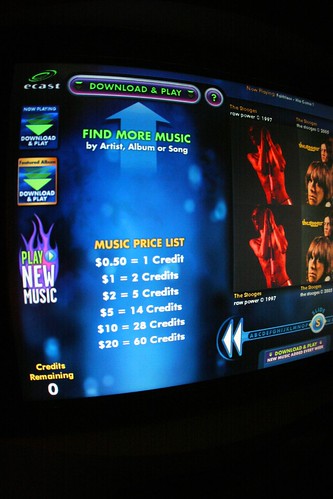
A music snob can rock one of these jukeboxes all night long (at 50 cents a song it's a good thing they take credit cards!). But on the other hand, so can any asshole with bad taste and a wallet full of cash or plastic. The point is that it takes the fun out of having bar owners and staff stock the jukebox for the bar. A jukebox is as important to a bar’s identity as the man slinging whiskey bottles, and a bar whose clientele listen mainly to Wire and X should have a jukebox that reflects this. We should not have to be in danger of hearing Britney Spears or something equally awful.
Chances are that if there is nothing on the jukebox for you, that bar is not the place for you. While I tend to have a relatively egalitarian view regarding access to booze, I believe that by offering all music to everyone in any bar makes it more difficult to identify the “kind” of bar it is— biker bar, punk bar, etc. It is about personal choice, and I often use the jukebox as a gauge for deciding what kind of bar I’m in and whether or not I like it. The taste of music found in the jukebox is indicative of a bar’s personality, just as knowing that someone likes to bungee jump leads you to believe they are a risk-taker.
Herein lies the genius of the MP3 jukebox: because the selection is so limitless, you just can’t hear it all in one set. These things are cash cows. People keep coming back to hear more and more because they know it’s available. In a February 2005 article in the San Francisco Business Journal, Christian Vara of Melo-Tone Vending (the company operates 33 Ecast jukeboxes in and around Boston) is quoted:
My Ecast-powered jukeboxes outperform my CD jukeboxes by as much as 4-to-1. That's because they have access to such a huge catalog of music, and because they never go down.But the imperfections of regular jukeboxes are part of what makes them wonderful. The user interface on an MP3 jukebox is a brightly colored touch screen. As I mentioned in a previous post, the interface is reminiscent of a Wells Fargo ATM. Additionally, all of the albums are organized alphabetically. In an Ecast jukebox the amusement of seeing Al Green on top of Motorhead next to the Yeah Yeah Yeahs is lost—and with it the challenge of trying to correctly match the letters and numbers listed on the album in the box with the letters and numbers on the keypad with one eye open. The full color touch screen interface is as unfeeling and impersonal as the ridiculous messages the jukeboxes display when in “screensaver” mode (see the picture below).
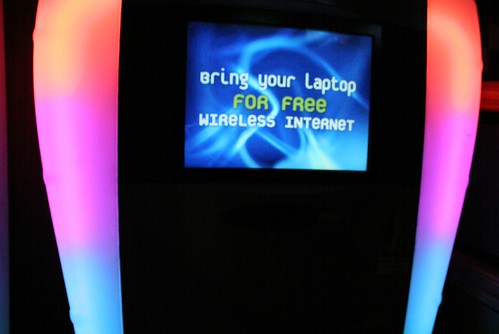
Imagine if Zeitgeist got one of these. Can you picture the legions of people working on laptops at the picnic tables on summer days? I can and I don't like it.
I partially intend this project to be about the bars as much as the jukeboxes. To me, the two are often inseparable. I go to certain bars because I love their jukeboxes, and I love the control over what CAN’T be played that is exercised by the bar’s staff (via exclusion). So the main problem for me, above all else, is the loss of something unique to a bar’s identity. Take, for instance, the difficulty I had writing the post for the Valley Tavern. There is no way I can chronicle 3,000 albums with just a pen, a notebook, and jkoshi’s camera to work with, but I also know that each Ecast jukebox I encounter will offer the same selection. There will be no highlights or low lights, because then I might as well copy and paste the same post for all of them. Instead, I have to concentrate on what people play on them, and how that fits into the personality of the bar: what was played that was great, what was played that should never be played again, what I happened to notice while flipping through the albums in line for the bathroom. Thus, I will show how, contrary to Ecast’s statement at the head of this post, the jukebox is not being returned to its glory days at all, but being stripped of its individuality.
Wednesday, April 19, 2006
Something for Everyone Starving for Destruction at the 500 Club
500 Club
500 Guerrero Street (Guerrero @ 17th) [Map]
Total Spent: $8+
I've spent many a 1:23am in the 500 Club in just such a state. One evening in particular found a friend and I sitting at the booth equidistant from the door and jukebox. We'd already had far too much to drink—I can't remember if we had been at some random scenester hell indie show or at a baseball game. I do remember that after a few beers at the Five Hunny on top of our lethal doses of Maker's Mark, we were drumming and singing along to Guns & Roses, talking to a homeless man as if his life story was the most fascinating thing we'd ever heard. As I professed my love for Axl Rose, we put enough money in the 500 Club’s jukebox to play Appetite for Destruction several times.
Appetite for Destruction is no longer in the jukebox at the 500 Club. I doubt that we were solely responsible for its removal, but I like to think we were. It’s a loss for sure, but not a tragic one, as the scope of the selection in the box more than makes up for the absence of Slash and Axl. The selection is so good, in fact, that last week a few friends and I found ourselves arguing over the best use of our collective cash. It became quite a conversation piece, and not just because of the Fernet shots an eager friend forced us to throw down our gullets (we had just finished a huge meal and were all in need of a digestif).

A small sign below this one boasts a 6am opening time but (sadly) it's not true.
The content of the jukebox ranges from metal to jazz with indie, soul, country, and punk in between. It is an eclectic mix befitting the blend of patrons who tumble into the curved, black leather booths seeking a bar atmosphere reminiscent of the trailer park’s local dive (complete with a working fireplace, pool table, and a photobooth that refused to take any of our dollar bills). Among the Ramones, Black Sabbath, and the Circle Jerks, you’ll find jazz legends Getz, Mingus, and Sinatra; black American pioneers Lee Dorsey, James Brown, and Toots & the Maytal; music snob rock darlings Dinosaur Jr., the Replacements, and Alkaline Trio; and, tucked in among the beautiful gems, a very out of place Bloc Party. Even Hank Williams Jr., Sr., and the Third all make an appearance in the 500 Club juke. You get the feeling that everything in that jukebox has been carefully selected to minimize annoyance and maximize enjoyment. Like MP3 jukeboxes, there is something for everyone. Unlike MP3 jukeboxes, the offerings to everyone clearly define the staff and regular clientele—random Marina folk who have sojourned off the beaten Valencia path excluded.
It is hard to find highlights in a jukebox this good, but I’d have to say that the Repo Man soundtrack something I’ve not noticed elsewhere. Best of all, though, is a 22-track unlabeled CD that dares you to press your luck and choose a random track. I can’t remember if we tried it and if we did we were certainly in no condition to play a guessing game. So my challenge to you, readers, is to go to the 500 Club and figure out what the hell that album is. Is it a carefully selected mix or is it a single album? Could it perhaps be my precious Appetite for Destruction? Your guesses are welcome.
All in all, the 500 Club jukebox definitely ranks as the best so far. Of course, there are so many left to go…
500 Guerrero Street (Guerrero @ 17th) [Map]
Total Spent: $8+
This is always the place to go at 1:23 a.m. when you need one more glass of booze to quench the grinding loneliness, and you've slept with most of the bartenders so they have to serve you. A right fine place to stagger around in hoping that this time, you're gonna find 'The One' and not some alcoholic grease-ape who will leave you with nothing but a a taste of salt in your mouth and a sore asshole. Not that I speak from personal experience or anything. Be sure to lick the tables for a cheap cocaine high.
I've spent many a 1:23am in the 500 Club in just such a state. One evening in particular found a friend and I sitting at the booth equidistant from the door and jukebox. We'd already had far too much to drink—I can't remember if we had been at some random scenester hell indie show or at a baseball game. I do remember that after a few beers at the Five Hunny on top of our lethal doses of Maker's Mark, we were drumming and singing along to Guns & Roses, talking to a homeless man as if his life story was the most fascinating thing we'd ever heard. As I professed my love for Axl Rose, we put enough money in the 500 Club’s jukebox to play Appetite for Destruction several times.
Appetite for Destruction is no longer in the jukebox at the 500 Club. I doubt that we were solely responsible for its removal, but I like to think we were. It’s a loss for sure, but not a tragic one, as the scope of the selection in the box more than makes up for the absence of Slash and Axl. The selection is so good, in fact, that last week a few friends and I found ourselves arguing over the best use of our collective cash. It became quite a conversation piece, and not just because of the Fernet shots an eager friend forced us to throw down our gullets (we had just finished a huge meal and were all in need of a digestif).

A small sign below this one boasts a 6am opening time but (sadly) it's not true.
The content of the jukebox ranges from metal to jazz with indie, soul, country, and punk in between. It is an eclectic mix befitting the blend of patrons who tumble into the curved, black leather booths seeking a bar atmosphere reminiscent of the trailer park’s local dive (complete with a working fireplace, pool table, and a photobooth that refused to take any of our dollar bills). Among the Ramones, Black Sabbath, and the Circle Jerks, you’ll find jazz legends Getz, Mingus, and Sinatra; black American pioneers Lee Dorsey, James Brown, and Toots & the Maytal; music snob rock darlings Dinosaur Jr., the Replacements, and Alkaline Trio; and, tucked in among the beautiful gems, a very out of place Bloc Party. Even Hank Williams Jr., Sr., and the Third all make an appearance in the 500 Club juke. You get the feeling that everything in that jukebox has been carefully selected to minimize annoyance and maximize enjoyment. Like MP3 jukeboxes, there is something for everyone. Unlike MP3 jukeboxes, the offerings to everyone clearly define the staff and regular clientele—random Marina folk who have sojourned off the beaten Valencia path excluded.
It is hard to find highlights in a jukebox this good, but I’d have to say that the Repo Man soundtrack something I’ve not noticed elsewhere. Best of all, though, is a 22-track unlabeled CD that dares you to press your luck and choose a random track. I can’t remember if we tried it and if we did we were certainly in no condition to play a guessing game. So my challenge to you, readers, is to go to the 500 Club and figure out what the hell that album is. Is it a carefully selected mix or is it a single album? Could it perhaps be my precious Appetite for Destruction? Your guesses are welcome.
All in all, the 500 Club jukebox definitely ranks as the best so far. Of course, there are so many left to go…
Monday, April 10, 2006
Close Encounters of the MP3 Kind at the Valley Tavern
The Valley Tavern
4054 24th St. (btwn Noe and Castro) [Map]
Total spent: $0
Noe Valley’s population contains a much larger working class faction than the yuppies flocking to 24th Street’s bourgeois eateries, bars, and boutiques would like to acknowledge. But neighborhood watering holes like the Valley Tavern (on 24th between Noe and Castro) still find their bar stools occupied by construction workers, old time barflies, and average Joes. They are havens for the dwindling non-yuppie population of the neighborhood and one would think the jukeboxes should reflect the last vestiges of the Noe Valley working class the way the bar does. At the Valley Tavern, however, this is not the case.
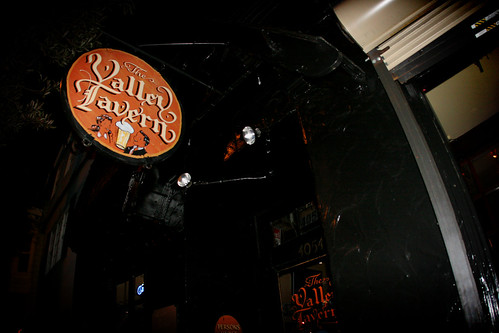
The Valley Tavern has an Ecast MP3 jukebox. A more detailed post on MP3 jukeboxes lies in the near future, so I will focus on what happens when such a travesty pops up in a good local bar. When such a vast library as that in an MP3 jukebox appears in a bar with such a mixed crew of drunkards like the Valley Tavern attracts, trouble is likely to ensue. Case in point: somebody managed to scrape enough circa 2000 New York City club trance music to torture me for nearly a half hour. Thanks to the sensitive neighbors, the Valley Tavern’s outdoor area closes early, at 8:30pm, so my only escape was the smoking room in the front of the bar and even there I was not free of the noise.
Although the Valley Tavern is a bit classier than your average dive, it's hardly Noe Valley chic. One would imagine that behind the glass a music fan would encounter classics like Elvis, Hank Williams, and Fleetwood Mac. Sure, all of this stuff is in the MP3 juke’s library; but so is a whole bunch of other crap. As delighted as I was to see Edith Piaf and Leonard Cohen at first glance, they simply don’t belong in the Valley Tavern. I happened to be at the bar for a friend’s birthday on Saturday night, and I’d like to use his song selections as examples of what actually does belong here. Tom Petty belongs here. Aerosmith belongs here. Oldies compilations belong here. Common music for the common man and none of this bullshit for the wayward wannabe club kids.
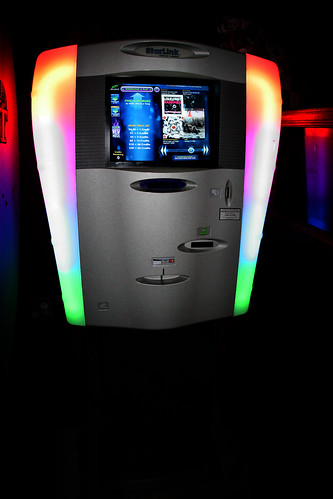
Take me to your leader.
One would also imagine that the jukebox in a bar like this would be dirty and its control pad worn from grubby fingers keying selections. Alas, this is not so. As if it’s not sad enough that the Valley Tavern has brought in an MP3 jukebox, they have also happened to invest in one of the ugliest jukeboxes I’ve ever seen—digital or otherwise. It looks like a bodega ATM with a Wells Fargo display.
Obviously, the Valley Tavern jukebox is just like all other MP3 jukeboxes with its enormous library. It just doesn’t belong here. But perhaps the presence of the MP3 jukebox truly is perfect for this Noe Valley establishment, another sign of the class changing of the guard in this neighborhood.
4054 24th St. (btwn Noe and Castro) [Map]
Total spent: $0
Noe Valley’s population contains a much larger working class faction than the yuppies flocking to 24th Street’s bourgeois eateries, bars, and boutiques would like to acknowledge. But neighborhood watering holes like the Valley Tavern (on 24th between Noe and Castro) still find their bar stools occupied by construction workers, old time barflies, and average Joes. They are havens for the dwindling non-yuppie population of the neighborhood and one would think the jukeboxes should reflect the last vestiges of the Noe Valley working class the way the bar does. At the Valley Tavern, however, this is not the case.

The Valley Tavern has an Ecast MP3 jukebox. A more detailed post on MP3 jukeboxes lies in the near future, so I will focus on what happens when such a travesty pops up in a good local bar. When such a vast library as that in an MP3 jukebox appears in a bar with such a mixed crew of drunkards like the Valley Tavern attracts, trouble is likely to ensue. Case in point: somebody managed to scrape enough circa 2000 New York City club trance music to torture me for nearly a half hour. Thanks to the sensitive neighbors, the Valley Tavern’s outdoor area closes early, at 8:30pm, so my only escape was the smoking room in the front of the bar and even there I was not free of the noise.
Although the Valley Tavern is a bit classier than your average dive, it's hardly Noe Valley chic. One would imagine that behind the glass a music fan would encounter classics like Elvis, Hank Williams, and Fleetwood Mac. Sure, all of this stuff is in the MP3 juke’s library; but so is a whole bunch of other crap. As delighted as I was to see Edith Piaf and Leonard Cohen at first glance, they simply don’t belong in the Valley Tavern. I happened to be at the bar for a friend’s birthday on Saturday night, and I’d like to use his song selections as examples of what actually does belong here. Tom Petty belongs here. Aerosmith belongs here. Oldies compilations belong here. Common music for the common man and none of this bullshit for the wayward wannabe club kids.

Take me to your leader.
One would also imagine that the jukebox in a bar like this would be dirty and its control pad worn from grubby fingers keying selections. Alas, this is not so. As if it’s not sad enough that the Valley Tavern has brought in an MP3 jukebox, they have also happened to invest in one of the ugliest jukeboxes I’ve ever seen—digital or otherwise. It looks like a bodega ATM with a Wells Fargo display.
Obviously, the Valley Tavern jukebox is just like all other MP3 jukeboxes with its enormous library. It just doesn’t belong here. But perhaps the presence of the MP3 jukebox truly is perfect for this Noe Valley establishment, another sign of the class changing of the guard in this neighborhood.
Friday, April 07, 2006
Mission Bar's Mediocre Greatest Hits/Best Of Collection
Mission Bar
2695 Mission St. (@ 23rd) [Map]
Total spent: $7
Known to me for a long time simply as "BAR" because of the giant red sign above the door, Mission Bar on Mission at 23rd is just far enough from the 16th Street nexus that it is never crowded on week nights and is usually navigable on the weekends, even with a crowd. Since the throngs stay away, there is plenty of opportunity to control the music, but bring a jacket if you plan to spend time there because the jukebox is positioned right behind the door at the front of the bar.
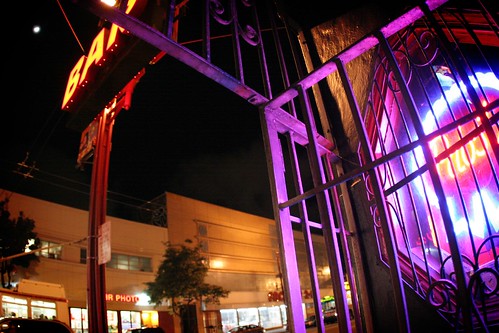
BAR's jukebox and I started off on a bad note when a friend of mine played the Me First and the Gimme Gimmes cover of "Sloop John B" off of their second album, Blow in the Wind. The covers band and their fans may think that the pop punk renditions of oldies are cute and kitschy, but they are really not, and there is no room in a jukebox for this kind of half-rate novelty crap. There is, however, room for the original classics, and fortunately BAR has several albums' worth of those. Unfortunately, a couple of them are shoddily listed, showing only song titles without the artist names. Yes, I do need to see "The Searchers" next to "Love Potion No. 9." How else will my drunk friends and I settle bets over who sings what? The track lists are the jukebox equivalent of MP3 metadata and I insist that they be accurate and complete. Critical failure, BAR.
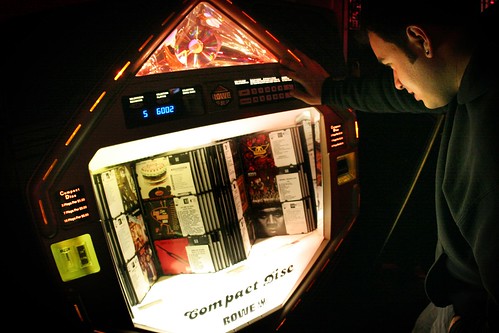
My friend plots his aural torture.
Not that it's necessarily a bad thing, but much like the type of clientele—barflies, hipsters, neighborhood residents—BAR’s jukebox lacks consistency in selection. It ranges from Howlin’ Wolf to the Urban Cowboy soundtrack, but consists mostly of greatest hits and best of albums, and that is what makes it unremarkable. Prince's Hits, Joan Jett's Greatest Hits, even Whitesnake’s Greatest Hits, which gave me the opportunity to play an old favorite and long-time guilty pleasure, “Here I Go Again On My Own.” Clearly, there is something for everyone—including old standbys like Beastie Boys’ Paul’s Boutique and Guns & Roses’ Appetite for Destruction (which I have been known to play start-to-finish on jukeboxes after the 10th beer)—but not a lot of it.
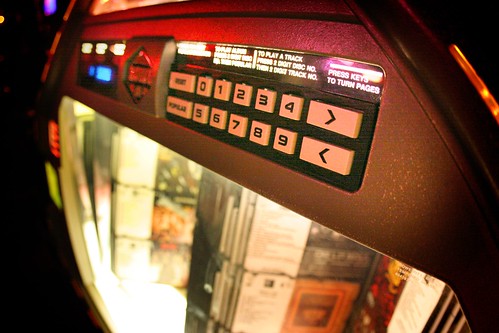
One notable gem within this otherwise mediocre collection is a Ruth Brown track on one of the properly annotated oldies compilations. Unfortunately, the R&B queen is all-too-rarely found on bar jukeboxes mainly because most of the world has no idea who she is. [I wanted to post a track for download but unfortunately Ruth Brown's albums are owned by the RIAA.] Ween’s album White Pepper is in there too, which struck me as unusual given the juke’s propensity toward oldies, blues, and punk. There are also a couple of “Mission Bar Mixes” in the juke that provide popular singles whose albums of origin are not in the jukebox. George Michael’s “Faith,” for instance, can be found on one of the custom mixes but that is the only instance of the gay Australian with the great ass.
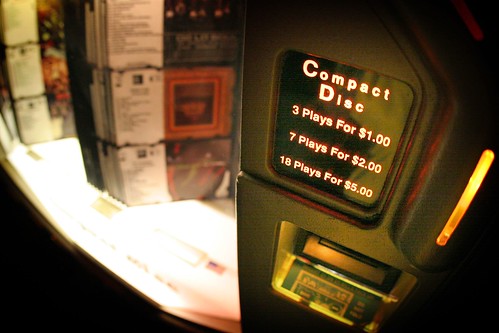
In short, this is not the kind of jukebox that would devour the ones in your wallet. Those George Washingtons are much better used to tip the disaffected bar staff, although on a slow night the quiet might drive you to feed some Georges to the magic music machine. Finding a couple rounds of songs is not difficult, but there’s nothing that will blow your mind.
2695 Mission St. (@ 23rd) [Map]
Total spent: $7
Known to me for a long time simply as "BAR" because of the giant red sign above the door, Mission Bar on Mission at 23rd is just far enough from the 16th Street nexus that it is never crowded on week nights and is usually navigable on the weekends, even with a crowd. Since the throngs stay away, there is plenty of opportunity to control the music, but bring a jacket if you plan to spend time there because the jukebox is positioned right behind the door at the front of the bar.

BAR's jukebox and I started off on a bad note when a friend of mine played the Me First and the Gimme Gimmes cover of "Sloop John B" off of their second album, Blow in the Wind. The covers band and their fans may think that the pop punk renditions of oldies are cute and kitschy, but they are really not, and there is no room in a jukebox for this kind of half-rate novelty crap. There is, however, room for the original classics, and fortunately BAR has several albums' worth of those. Unfortunately, a couple of them are shoddily listed, showing only song titles without the artist names. Yes, I do need to see "The Searchers" next to "Love Potion No. 9." How else will my drunk friends and I settle bets over who sings what? The track lists are the jukebox equivalent of MP3 metadata and I insist that they be accurate and complete. Critical failure, BAR.

My friend plots his aural torture.
Not that it's necessarily a bad thing, but much like the type of clientele—barflies, hipsters, neighborhood residents—BAR’s jukebox lacks consistency in selection. It ranges from Howlin’ Wolf to the Urban Cowboy soundtrack, but consists mostly of greatest hits and best of albums, and that is what makes it unremarkable. Prince's Hits, Joan Jett's Greatest Hits, even Whitesnake’s Greatest Hits, which gave me the opportunity to play an old favorite and long-time guilty pleasure, “Here I Go Again On My Own.” Clearly, there is something for everyone—including old standbys like Beastie Boys’ Paul’s Boutique and Guns & Roses’ Appetite for Destruction (which I have been known to play start-to-finish on jukeboxes after the 10th beer)—but not a lot of it.

One notable gem within this otherwise mediocre collection is a Ruth Brown track on one of the properly annotated oldies compilations. Unfortunately, the R&B queen is all-too-rarely found on bar jukeboxes mainly because most of the world has no idea who she is. [I wanted to post a track for download but unfortunately Ruth Brown's albums are owned by the RIAA.] Ween’s album White Pepper is in there too, which struck me as unusual given the juke’s propensity toward oldies, blues, and punk. There are also a couple of “Mission Bar Mixes” in the juke that provide popular singles whose albums of origin are not in the jukebox. George Michael’s “Faith,” for instance, can be found on one of the custom mixes but that is the only instance of the gay Australian with the great ass.

In short, this is not the kind of jukebox that would devour the ones in your wallet. Those George Washingtons are much better used to tip the disaffected bar staff, although on a slow night the quiet might drive you to feed some Georges to the magic music machine. Finding a couple rounds of songs is not difficult, but there’s nothing that will blow your mind.
Thursday, April 06, 2006
San Francisco Songs on San Francisco Jukeboxes
I was sitting in a bar in North Beach one night, killing some time before meeting a friend for a show at Bimbo’s, and the place was full of tourists—tourists who could not keep their hands off of the jukebox. Naturally, since the bar is in North Beach, the jukebox is well stocked with all of those songs about San Francisco that I would prefer to get through a few beers without hearing several times. There are a lot of them. And apparently not only do the tourists know all of them, they also love to play them in San Francisco bars as if they need to “get into the spirit.” I lived in New York for four years and I didn’t heard Frank Sinatra’s “New York, New York” on jukeboxes as many times as in my two San Francisco years I’ve heard Otis Redding’s “(Sitting on the) Dock of the Bay.” Granted, it is an awesome song, but after the third time in the same night, that whistling bit at the end starts to grate on my nerves. I am prone to hyperbole, but I swear I am not exaggerating, I have heard it multiple times in one night on multiple occasions.
Here are five songs that San Francisco bars should banish from their jukeboxes due to outsider abuse*:
Five San Francisco songs that are under appreciated and should pop up more often:
* Truth is, though, that I’m a bit of a hypocrite. It is not unlikely for me to use a play to hear any one of those five overplayed songs, depending on number of beers powering my decision making process.
Here are five songs that San Francisco bars should banish from their jukeboxes due to outsider abuse*:
- Scott McKenzie, “If You’re Going to San Francisco”
Sweet-voiced McKenzie popularized this infectious pop song and the great thing about it is how it essentially chronicles a period and mood in San Francisco with its lyrics. But everybody from Nebraska to Kuala Lumpur knows this song and they are not afraid to play it. Many, many times. - Starship, “We Built This City”
San Francisco-based Jefferson Airplane devolved into Starship and made one of the most banal and nauseating songs EVER. Why did this happen? - Tony Bennett, “I Left My Heart In San Francisco”
I blame one particular incident for my disgust with this song’s presence in watering hole music machines. It was my first and only trip to Trad’r Sam in the Richmond. The jukebox there is horrendous, and the clientele loves this song like no other Tony Bennet song in his career history. I almost unplugged the jukebox after the 3rd play that night. - Otis Redding, “(Sittin’ on the) Dock of the Bay”
I expect that, if anybody actually ever reads this post, I stand to discredit myself with this particular opinion. But really, I can’t take it after a while. This was one of my favorite songs as a kid growing up in bumblefuck Pennsylvania, though. I love it. I listen to it frequently. But nobody can deny that it is played so often it becomes annoying. - Journey, “Lights”
When the lights go down in the city and the sun shines on the Bay, I usually don’t want to be anywhere but in bed, assuming they really are talking about morning. I hate this song.
Five San Francisco songs that are under appreciated and should pop up more often:
- The Animals, “San Francisco Night”
It’s like “House of the Rising Sun” meets “Little Red Riding Hood” by Sam the Sham and the Pharoahs. More bars need to have it, and more people need to love it. - The Staple Singers, “(Sittin’ on the) Dock of the Bay”
This cover of Otis Redding is seriously under appreciated. It’s just the right combination of sweet and soul. If it were overplayed, I would probably start to hate it, but since I never hear it when I’m out I believe people need to care more about it. - Doug Sahm, “Westside Blues”
Texas native and Bay Area transplant Doug Sahm wrote a number of songs about Bay Area towns and landmarks, but none better capture the feelings of being an outsider and homesickness inevitable for those of us who move here from elsewhere in the country. It is bluesy and goes great with a glass of bourbon. Not that I would do that sort of thing… - Red House Painters, “Grace Cathedral Park”
San Francisco’s saddest resident Mark Kozelek performs frequently in the city. On his most recent tour, fans were delighted that he pulled out “Grace Cathedral Park.” It’s definitely not a happy song, but neither is life in this city all the time. Pour me an Anchor Steam and bring on the sadcore. - Mel Torme, “Got the Date on the Golden Gate”
I find that Mel Torme is under appreciated in general, particularly by people of my generation, and I think it’s time to cover the world in Velvet Fog. I think this song, posing as a song about Manhattan and not San Francisco, should be our city anthem.
* Truth is, though, that I’m a bit of a hypocrite. It is not unlikely for me to use a play to hear any one of those five overplayed songs, depending on number of beers powering my decision making process.
Thursday, March 16, 2006
SF Jukebox Index to Posts
Jukeboxes Reviewed (by Neighborhood)
Bernal HeightsWild Side West (5/3/06)
The Mission
Martuni's (3/26/08)
O'Greenberg's (4/5/07)
Mission Bar (4/7/06)
500 Club (4/19/06)
Doc's Clock (9/20/06)
Dovre Club (5/8/07)
Noe Valley
The Valley Tavern (4/10/06)
Show Reviews (by Venue)
Berkeley Community TheaterSonic Youth, Daydream Nation Tour (7/19/07)
Bimbo's 365 Club
The Sea and Cake (5/18/07)
Stereo Total (9/6/07)
Bottom of the Hill
Acid Mothers Temple & the Melting Paraiso U.F.O. (4/8/08)
The Fillmore
Tea Leaf Green (4/20/07)
Great American Music Hall
Low (9/25/07)
Joanna Newsom (12/19/06)
The Independent
Bustle In Your Hedgerow (The Led Zeppelin Experience) (5/11/07)
US Air Guitar, San Francisco Regional Championships (6/28/07)
Two Gallants w/Blitzen Trapper (10/26/07)
The Walkmen (11/13/07)
Slim's
Phoenix and La Rocca (9/23/06)
Do Make Say Think (3/9/07)
Explosions In The Sky (5/1/07)
Guest Reviews
Foreigner @ Mountain Winery by Faceword & Dennis (9/13/07)Interviews
Not Just For Superman: Rocking Out at the Phone Booth (7/11/2006)Other Posts
San Francisco Songs on San Francisco Jukeboxes (4/6/06)MP3s are for iPods, not Jukeboxes (4/26/06)
SFWeekly: Best Jukebox in San Francisco, 2007 (5/18/07)
Air Guitar Update (6/28/07)
Announcements
An Important Announcement (3/21/07)
Labels:
index
Subscribe to:
Posts (Atom)

